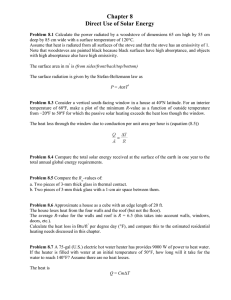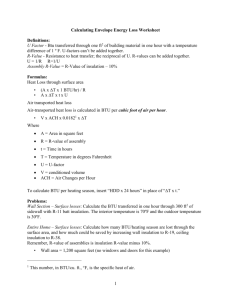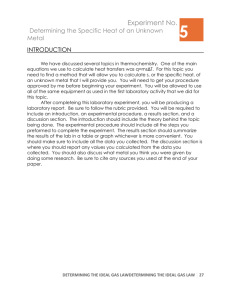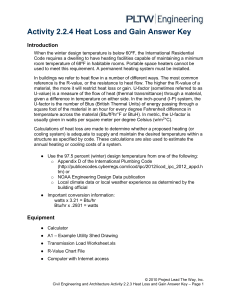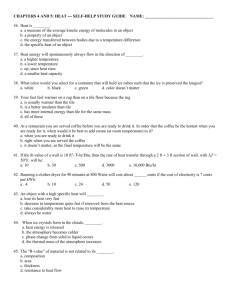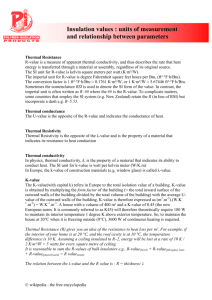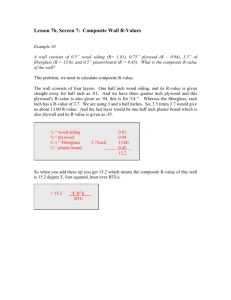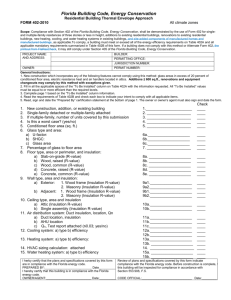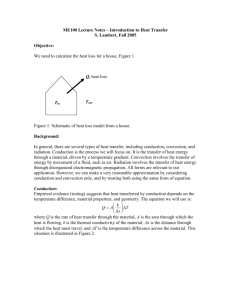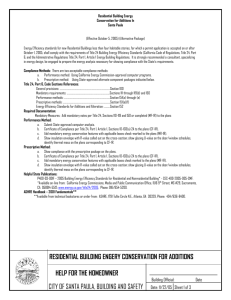Activity 2.2.3 Heat Loss and Gain
advertisement
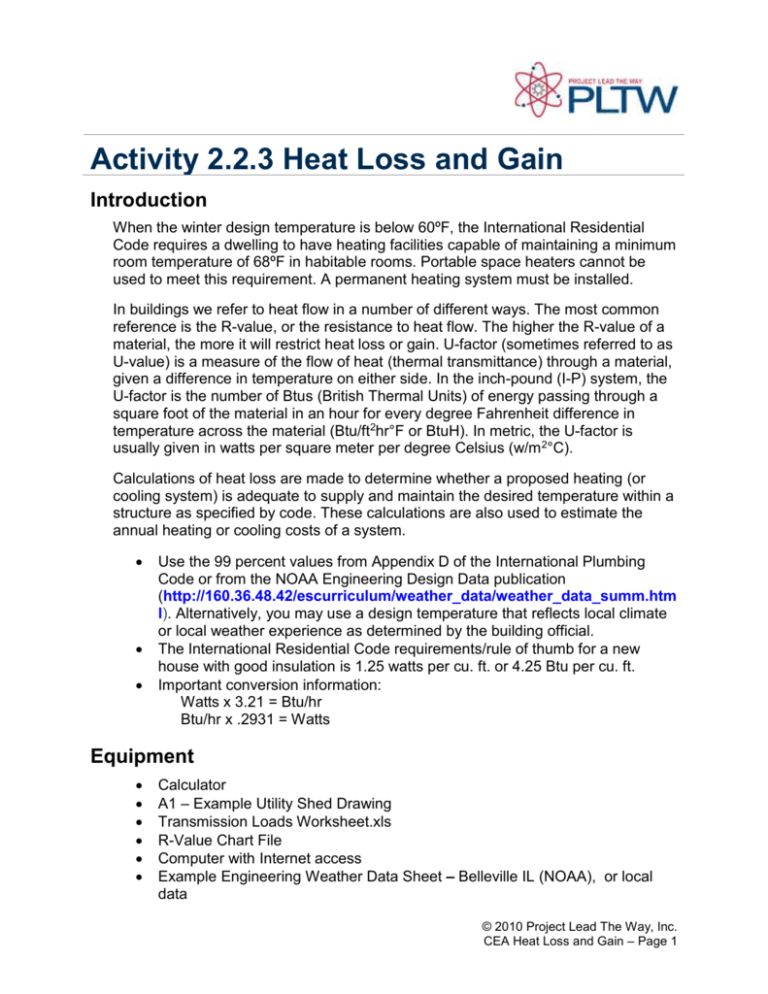
Activity 2.2.3 Heat Loss and Gain Introduction When the winter design temperature is below 60ºF, the International Residential Code requires a dwelling to have heating facilities capable of maintaining a minimum room temperature of 68ºF in habitable rooms. Portable space heaters cannot be used to meet this requirement. A permanent heating system must be installed. In buildings we refer to heat flow in a number of different ways. The most common reference is the R-value, or the resistance to heat flow. The higher the R-value of a material, the more it will restrict heat loss or gain. U-factor (sometimes referred to as U-value) is a measure of the flow of heat (thermal transmittance) through a material, given a difference in temperature on either side. In the inch-pound (I-P) system, the U-factor is the number of Btus (British Thermal Units) of energy passing through a square foot of the material in an hour for every degree Fahrenheit difference in temperature across the material (Btu/ft2hr°F or BtuH). In metric, the U-factor is usually given in watts per square meter per degree Celsius (w/m 2°C). Calculations of heat loss are made to determine whether a proposed heating (or cooling system) is adequate to supply and maintain the desired temperature within a structure as specified by code. These calculations are also used to estimate the annual heating or cooling costs of a system. Use the 99 percent values from Appendix D of the International Plumbing Code or from the NOAA Engineering Design Data publication (http://160.36.48.42/escurriculum/weather_data/weather_data_summ.htm l). Alternatively, you may use a design temperature that reflects local climate or local weather experience as determined by the building official. The International Residential Code requirements/rule of thumb for a new house with good insulation is 1.25 watts per cu. ft. or 4.25 Btu per cu. ft. Important conversion information: Watts x 3.21 = Btu/hr Btu/hr x .2931 = Watts Equipment Calculator A1 – Example Utility Shed Drawing Transmission Loads Worksheet.xls R-Value Chart File Computer with Internet access Example Engineering Weather Data Sheet – Belleville IL (NOAA), or local data © 2010 Project Lead The Way, Inc. CEA Heat Loss and Gain – Page 1 Procedure Heat Loss from the Utility Shed In this activity you will calculate the total heat transmission load measured in Btu/H for the Example Utility Shed shown in Drawing A1. Assume the following: For this exercise the floor will be ignored One double door, 72in. x 7ft Two single-glazed windows, 2ft x 4ft Desired inside temperature of 70°F Outside winter design temperature taken as the 99% value (refer to the Example Engineering Weather Data Sheet, International Plumbing Code, or local data) 1. R-Value Calculate the total R-value for each surface including the four walls, the door, the windows, and the ceiling/roof structure. Use the R-value chart to find the R-value for the individual layers within the wall. Drawing A1 shows the different layers that comprise the wall and ceiling/roof. Include an inside air film layer. Calculating Assembly R-Values R-values, which are standard in the construction industry, identify the thermal resistance of a material. The higher an R-value, the better the insulation against heat transfer. A higher R-value means that less heat energy passes through the material. Use the R-Value and Densities Charts handout to determine R-values for individual components. The R-value for assemblies of components, such as a wall or roof system, can be determined by adding the R-values of all of the components of the assembly. The Rvalue for the Example Utility Shed wall would be calculated as follows: 1.05 0.70 0.00 11.0 0.70 0.68 14.13 Wood Bevel Siding (3/4in. x 10in.) Wood Sheathing (OSB - Low Density = 1.41 x .5 inches of thickness) Vapor Barrier R-11 Batt Insulation Wood Sheathing (OSB - Low Density = 1.41 x .5 inches of thickness) Inside Air Film R-Value for Example Utility Shed Wall © 2010 Project Lead The Way, Inc. CEA Heat Loss and Gain – Page 2 Surface West Wall East Wall North Wall South Wall Ceiling/Roof Door Window U-Factor R-Value 1/R .070 .070 .07 14.13 14.13 14.13 14.13 Area ΔT Square Feet Degrees F Transmission Load Btu/Hour 1.67 .88 2. Convert R-value to U-factor Convert all R-values to U-factors. The U-factor is the reciprocal of the R-value. When R-values are converted to U-factors, at least the first three decimal places must be used. Do not round the third digit. If the R-Value for a given wall is 12.70 (1/12.70 = .078740157), the U-factor used would be .078. Surface West Wall R-Value 14.13 U-Factor 1/R .070 Area ΔT Square Feet Degrees F Transmission Load Btu/Hour 3. Area Compute the area for each of the surfaces under consideration and enter the square footage in the appropriate column. For walls with openings, be sure to subtract the area of the opening. For the North and South walls, you must add in the triangular area at the top of the wall. For the roof/ceiling, you must calculate the actual area of the sloped roof surface. Surface West Wall R-Value 14.13 U-Factor 1/R .070 Area Square Feet 128 ΔT Degrees F Transmission Load Btu/Hour 4. Design Temperature Differential Find the design temperature difference (ΔT) between the desired inside temperature and the outside winter design temperature for the region in which you are building. The desired inside temperature is 70ºF. If you use the Example Engineering Design Data Sheet (Belleville, IL), the outside winter design temperature (99% value) is 9ºF. Therefore, ΔT = 70 – 9 = 61ºF. This value may change for other locations. Surface West Wall R-Value 14.13 U-Factor 1/R .070 Area Square Feet 128 ΔT Degrees F 61 Transmission Load Btu/Hour © 2010 Project Lead The Way, Inc. CEA Heat Loss and Gain – Page 3 5. Transmission Load Calculating Heat Loss/Gain: To calculate heat loss (or gain), the following formula will be used: Q UA(T ) , where Q' is the heat loss in Btus per hour (Btu/H) U is the reciprocal of the R-Value, U 1 R A is the area of the surface ∆T is the difference in temperature on either side of the wall. You may round the transmission load to the nearest whole number. Surface R-Value ΔT U-Factor Area 1/R Square Feet Transmission Load West Wall 14.13 0.070 128 Degrees F 61 East Wall 14.13 0.070 112 61 483 North Wall 14.13 0.070 96 61 410 South Wall 14.13 0.070 54 61 230 1.67 .590 42 61 1511 16 61 1112 4293 Btu/Hour 547 Ceiling/Roof Door Window .88 1.140 TOTAL TRANSMISSION LOAD After finding the total Btu/H for each surface (walls, window, door, roof/ceiling), total all transmission loads for the structure. Optional: Use the Excel Transmission Loads Worksheet and create your transmission loads table electronically using appropriate formulas to calculate the Ufactor and the transmission loads. 6. Size Unit If heat loss through the building components is the only consideration, what size heating unit should you specify for the Example Utility Shed? Note that heating units are often specified to the nearest 1,000 Btu/H. A 5,000 Btu/H heating unit Assume that you had just performed the previous calculation such that you had found the heat gain in the summer (rather than the heat loss in the winter). What © 2010 Project Lead The Way, Inc. CEA Heat Loss and Gain – Page 4 size air conditioning unit would you need if there are two people working in the shed (adding 450 But/H) and equipment that contributes 2000 Btu/H heat gain? Note that air conditioners are often sized by the ton. Remember that 1 ton of unit capacity = 12,000 Btu/H. Round up to the next half ton. A 1 ton air conditioning unit 7. Energy Efficiency/Savings What modifications could be made to this structure to make it more energy efficient? Implement at least one change to the design and then show the change it makes to the total heat transmission load using the Excel Transmission Loads Worksheet.xls. Some changes you may want to consider include double-glazed windows, insulated doors, and/or a more effective insulation. Energy efficient design components should be noted in blank rows of the Transmission Loads Worksheet such that the transmission load for each surface in the redesigned envelop is shown in the right column on the transmission load worksheet. What is the difference in Btu/H? Btu/H Savings: _________479______ Conclusion 1. Where does the greatest heat loss occur in this structure? 2. What was the most significant change made to make this structure more energy efficient? 3. What effect could using 2x6 studs in the shed construction have on energy heat loss/gain? © 2010 Project Lead The Way, Inc. CEA Heat Loss and Gain – Page 5
